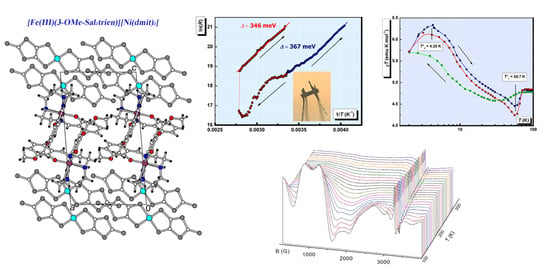Magnetism, Conductivity and Spin-Spin Interactions in Layered Hybrid Structure of Anionic Radicals [Ni(dmit)2] Alternated by Iron(III) Spin-Crossover Complex [Fe(III)(3-OMe-Sal2trien)] and Ferric Moiety Precursors
Abstract
:1. Introduction
2. Results and Discussion
2.1. Crystal Structure
2.1.1. [Fe(III)(3-OMe-Sal2trien)][Ni(dmit)2] (1)
2.1.2. [Fe(III)(3-OMe-Sal2trien)]NO3·H2O (2)
2.1.3. [Fe(III)(3-OMe-Sal2trien)]I (3)
2.2. Magnetic Properties
Magnetic Susceptibility
2.3. Magnetization Curves
2.4. Transport Properties
2.5. EPR Properties
3. Materials and Methods
3.1. General
3.2. [Fe(3-OMe-Sal2trien)][Ni(dmit)2] (1)
3.3. [Fe(3-OMe-Sal2trien)]NO3·H2O (2)
3.4. [Fe(3-OMe-Sal2trien)]I (3)
3.5. Electron-Probe X-ray Spectral Microanalysis (RSMA)
3.6. Optical Characterization
3.7. X-ray Crystallography
3.8. Thermogravimetric Analysis
3.9. Measurements of Magnetic Properties
3.10. Measurements of Electrical Properties
3.11. Measurements of EPR Properties
4. Conclusions
Supplementary Materials
Author Contributions
Funding
Conflicts of Interest
References
- Ouahab, L. (Ed.) Multifunctional Molecular Materials; Pan Stanford Publishing Pte. Ltd.: Singapore, 2013. [Google Scholar]
- Halcrow, M.A. (Ed.) Spin-Crossover Materials: Properties and Applications; John Wiley & Sons: Oxford, UK, 2013. [Google Scholar]
- Coronado, E.; Day, P. Magnetic molecular conductors. Chem. Rev. 2004, 104, 5419. [Google Scholar] [CrossRef] [PubMed]
- Benelli, C.; Gatteschi, D. Introduction to Molecular Magnetism: From Transition Metals to Lanthanides; Wiley-VCH Verlag GmbH & Co.: Weinheim, Germany, 2015. [Google Scholar]
- Valade, L.; Malfant, I.; Faulmann, C. Multifunctional Molecular Materials; Ouahab, L., Ed.; Pan Stanford Publishing Pte. Ltd.: Singapore, 2013; pp. 149–184. [Google Scholar]
- Sato, O.; Li, Z.-Y.; Yao, Z.-S.; Kang, S.; Kanegawa, S. Spin-Crossover Materials: Properties and Applications; Halcrow, M.A., Ed.; John Wiley & Sons: Oxford, UK, 2013; pp. 304–319. [Google Scholar]
- Dunbar, K.R.; Achim, C.; Shatruk, M. Spin-Crossover Materials: Properties and Applications; Halcrow, M.A., Ed.; John Wiley & Sons: Oxford, UK, 2013; pp. 171–202. [Google Scholar]
- Cassoux, P. Molecular (super) conductors derived from bis-dithiolate metal complexes. Coord. Chem. Rev. 1999, 185–186, 213–232. [Google Scholar] [CrossRef]
- Kato, R. Conducting metal dithiolene complexes: Structural and electronic properties. Chem. Rev. 2004, 104, 5319–5346. [Google Scholar] [CrossRef] [PubMed]
- Spitsyna, N.; Shvachko, Y.; Starichenko, D.; Lahderanta, E.; Komlev, A.; Zorina, L.; Simonov, S.; Blagov, M.; Yagubskii, E.B. Evolution of Spin-Crossover Transition in Hybrid Crystals Involving Cationic Iron Complexes [Fe(III)(3-OMe-Sal2trien)]+ and Anionic Gold Bis(dithiolene) Complexes Au(dmit)2 and Au(dddt)2. Crystals 2018, 8, 382. [Google Scholar] [CrossRef] [Green Version]
- Shvachko, Y.N.; Starichenko, D.V.; Korolyov, A.V.; Kotov, A.I.; Buravov, L.I.; Zverev, V.N.; Simonov, S.V.; Zorina, L.V.; Yagubskii, E.B. The highly conducting spin-crossover compound combining Fe(III) cation complex with TCNQ in a fractional reduction state. Synthesis, structure, electric and magnetic properties. Magnetochemistry 2017, 3, 9. [Google Scholar] [CrossRef] [Green Version]
- Pereira, L.; Gulamhussen, A.; Dias, J.; Santos, I.; Almeida, M. Searching for switchable molecular conductors: Salts of [M(dcbdt)2] (M=Ni, Au) anions with [Fe(sal2-trien)]+ and [Fe(phen)3]2+. Inorg. Chim. Acta 2007, 360, 3887–3895. [Google Scholar] [CrossRef]
- Lefter, C.; Davesne, V.; Salmon, L.; Molnar, G.; Demont, P.; Rotaru, A.; Bousseksou, A. Charge Transport and Electrical Properties of Spin Crossover Materials: Towards Nanoelectronic and Spintronic Devices. Magnetochemistry 2016, 2, 18. [Google Scholar] [CrossRef] [Green Version]
- Sato, O. Dynamic molecular crystals with switchable physical properties. Nat. Chem. 2016, 8, 644–656. [Google Scholar] [CrossRef]
- Hayami, S.; Gu, Z.Z.; Shiro, M.; Einaga, Y.; Fujishima, A.; Sato, O. First observation of light-induced excited spin state trapping for an iron(III) complex. J. Am. Chem. Soc. 2000, 122, 7126–7127. [Google Scholar] [CrossRef]
- Phan, H.; Benjamin, S.M.; Steven, E.; Brooks, J.S.; Shatruk, M. Photomagnetic response in highly conductive iron(II) spin-crossover complexes with TCNQ radicals. Angew. Chem. Int. Ed. 2015, 54, 823–827. [Google Scholar] [CrossRef]
- Wang, M.S.; Xu, G.; Zhang, Z.J.; Guo, G.C. Inorganic-organic hybrid photochromic materials. Chem. Commun. 2010, 46, 361–376. [Google Scholar] [CrossRef] [PubMed]
- Coronado, E.; Gimenez-Lopez, M.C.; Gimenez-Saiz, C.; Romero, F.M. Spin crossover complexes as building units of hydrogen-bonded nanoporous structures. CrystEngComm 2009, 11, 2198. [Google Scholar] [CrossRef]
- Vieira, B.; Dias, J.; Santos, I.; Pereira, L.; da Gama, V.; Waerenborgh, J. Thermal Hysteresis in a Spin-Crossover FeIII Quinolylsalicylaldimine Complex, FeIII(5-Br-qsal)2Ni(dmit)2·solv: Solvent Effects. Inorg. Chem. 2015, 54, 1354–1362. [Google Scholar] [CrossRef] [PubMed]
- Sato, O.; Tao, J.; Zhang, Y.Z. Control of magnetic properties through external stimuli. Angew. Chem. Int. Ed. 2007, 46, 2152–2187. [Google Scholar] [CrossRef]
- Saito, G.; Yoshida, Y. Development of conductive organic molecular assemblies: Organic metals, superconductors, and exotic functional materials. Bull. Chem. Soc. Jap. 2007, 80, 1–137. [Google Scholar] [CrossRef]
- Morita, Y.; Murata, T.; Nakasuji, K. Cooperation of hydrogen-bond and charge-transfer interactions in molecular complexes in the solid state. Bull. Chem. Soc. Jap. 2013, 86, 183–197. [Google Scholar] [CrossRef] [Green Version]
- Pritchard, P.; Barrett, S.; Kilner, C.; Halcrow, M. The influence of ligand conformation on the thermal spin transitions in iron(III) saltrien complexes. Dalton Trans. 2008, 24, 3159–3168. [Google Scholar] [CrossRef]
- Okai, M.; Takahashi, K.; Sakurai, T.; Ohta, H.; Yamamoto, T.; Einaga, Y. Novel Fe(II) spin crossover complexes involving a chalcogen-bond and π-stacking interactions with a paramagnetic and nonmagnetic M(dmit)2 anion (M = Ni, Au; dmit = 4,5-dithiolato-1,3-dithiole-2thione). J. Mater. Chem. C 2015, 3, 7858–7864. [Google Scholar] [CrossRef]
- Blagov, M.A.; Krapivin, V.B.; Simonov, S.V.; Spitsyna, N.G. Insights into the influence of ethylene groups orientation on iron (III) spin state in the spin crossover complex [FeIII(Sal2-trien)]+. Dalton Trans. 2018, 47, 16040–16043. [Google Scholar] [CrossRef]
- Brooker, S. Spin crossover with thermal hysteresis: Practicalities and lessons learnt. Chem. Soc. Rev. 2015, 44, 2880. [Google Scholar] [CrossRef] [Green Version]
- Domracheva, N.; Pyataev, A.; Manapov, R.; Gruzdev, M.; Chervonova, U.; Kolker, A. Structural, Magnetic and Dynamic Characterization of Liquid Crystalline Iron(III) Schiff Base Complexes with Asymmetric Ligands. Eur. J. Inorg. Chem. 2011, 2011, 1219–1229. [Google Scholar] [CrossRef]
- Nemec, I.; Herchel, R.; Salitros, I.; Travnicek, Z.; Moncol, J.; Fuess, H.; Rubend, M.; Linert, W. Anion driven modulation of magnetic intermolecular interactions and spin crossover properties in an isomorphous series of mononuclear iron(III) complexes with a hexadentate Schiff base ligand. CrystEngComm 2012, 14, 7015–7024. [Google Scholar] [CrossRef]
- Dorbes, S.; Valade, L.; Real, J.A.; Faulmann, C. [Fe(sal2-trien)][Ni(dmit)2]: Towards switchable spin crossover molecular conductors. Chem. Commun. 2005, 1, 69–71. [Google Scholar] [CrossRef] [PubMed] [Green Version]
- Faulmann, C.; Dorbes, S.; Real, J.A.; Valade, L. Electrical conductivity and spin crossover: Towards the first achievement with a metal bis dithiolene complex. J. Low Temp. Phys. 2006, 142, 265. [Google Scholar] [CrossRef]
- Faulmann, C.; Jacob, K.; Dorbes, S.; Lampert, S.; Malfant, I.; Doublet, M.-L.; Valade, L.; Real, J.A. Electrical Conductivity and Spin Crossover: A New Achievement with a Metal Bis Dithiolene Complex. Inorg. Chem. 2007, 46, 8548–8559. [Google Scholar] [CrossRef]
- Faulmann, C.; Szilagyi, P.; Jacob, K.; Shahene, J.; Valade, L. Polymorphism and its effects on the magnetic behaviour of the [Fe(sal2-trien)][Ni(dmit)2] spin-crossover complex. New J. Chem. 2009, 33, 1268–1276. [Google Scholar] [CrossRef]
- Szilagyi, P.; Dorbes, S.; Molnar, G.; Real, J.; Homonnay, Z.; Faulmann, C.; Bousseksou, A. Temperature and pressure effects on the spin state of ferric ions in the [Fe(sal2trien)][Ni(dmit)2] spin crossover complex. J. Phys. Chem. Solids 2010, 69, 2681. [Google Scholar] [CrossRef] [Green Version]
- Faulmann, C.; Dorbes, S.; Lampert, S.; Jacob, K.; Molnár, G.; Bousseksou, A.; Real, J.; Valade, L. Crystal structure, magnetic properties and Mossbauer studies of [Fe(qsal)2][Ni(dmit)2]. Inorg. Chim. Acta 2007, 360, 3870–3878. [Google Scholar] [CrossRef]
- Takahashi, K.; Cui, H.-B.; Okano, Y.; Kobayashi, H.; Einaga, Y.; Sato, O. Electrical conductivity modulation coupled to a high-spin low-spin conversion in the molecular system [FeIII(qsal)2][Ni(dmit)2]3 CH3CN H2O. Inorg. Chem. 2006, 45, 5739. [Google Scholar] [CrossRef]
- Takahashi, K.; Cui, H.-B.; Okano, Y.; Kobayashi, H.; Mori, H.; Tajima, H.; Einaga, Y.; Sato, O. Evidence of the chemical uniaxial strain effect on electrical conductivity in the spin-crossover conducting molecular system: [FeIII(qnal)2][Pd(dmit)2]5 acetone. J. Am. Chem. Soc. 2008, 130, 6688. [Google Scholar] [CrossRef]
- Halcrow, M.A. Structure: Function relationships in molecular spin-crossover complexes. Chem. Soc. Rev. 2011, 40, 4119–4142. [Google Scholar] [CrossRef] [PubMed]
- Shvachko, Y.N.; Starichenko, D.V.; Korolyov, A.V.; Yagubskii, E.B.; Kotov, A.I.; Buravov, L.I.; Lyssenko, K.A.; Zverev, V.N.; Simonov, S.V.; Zorina, L.V.; et al. The conducting spin-crossover compound combining Fe(II) cation complex with TCNQ in a fractional reduction state. Inorg. Chem. 2016, 55, 9121–9130. [Google Scholar] [CrossRef] [PubMed] [Green Version]
- Kirmse, R.; Stach, J.; Dietzsch, W.; Steimecke, G.; Hoyer, E. Single-Crystal EPR Studies on Nickel(III), Palladium(III), and Platinum(II1) Dithiolene Chelates Containing the Ligands Isotrithionedithiolate, o-Xylenedithiolate, and Maleonitriledithiolate. Inorg. Chem. 1980, 19, 2679–2685. [Google Scholar] [CrossRef]
- Ivanova, T.A.; Mingalieva, L.V.; Ovchinnikov, I.V.; Turanova, O.A.; Ivanova, G.I.; Gilmutdinov, I.F. Lability of Spin State of Fe(III) Complexes with Tetradentate Schiff’s Bases. Russ. J. Gen. Chem. 2016, 86, 1647–1652. [Google Scholar] [CrossRef]
- Weil, J.A.; Wertz, J.E.; Bolton, J.R. Electron. Paramagnetic Resonance: Elementary Theory and Practical Applications; McGraw-Hill; John Wiley & Co.: New York, NY, USA, 1994. [Google Scholar]
- Bencini, A.; Gatteschi, D. Electron Paramagnetic Resonance of Exchange Coupled Systems; Springer: Berlin/Heidelberg, Germany, 1990. [Google Scholar]
- Steimecke, G.; Sieler, H.-J.; Kirmse, R.; Houer, E. 1.3-dithiol-2-thion-4.5 ditholat aus schwefelkohlenstoff und alkalimetall. Phosphorus Sulfur Relat. Elem. 1979, 7, 49. [Google Scholar] [CrossRef]
- Tweedle, M.F.; Wilson, L.J.J. Variable spin iron(III) chelates with hexadentate ligands derived from triethylenetetramine and various salicylaldehydes. Synthesis, characterization, and solution state studies of a new 2T → 6A spin equilibrium system. Am. Chem. Soc. 1976, 98, 4824. [Google Scholar] [CrossRef]
- Bruker. TOPAS 5 User Manual Software; Bruker AXS GmbH: Karlsruhe, Germany, 2015. [Google Scholar]
- Sheldrick, G.M. A short history of SHELX. Acta Crystallogr. Sect. A Found. Crystallogr. 2008, 64, 112–122. [Google Scholar] [CrossRef] [Green Version]



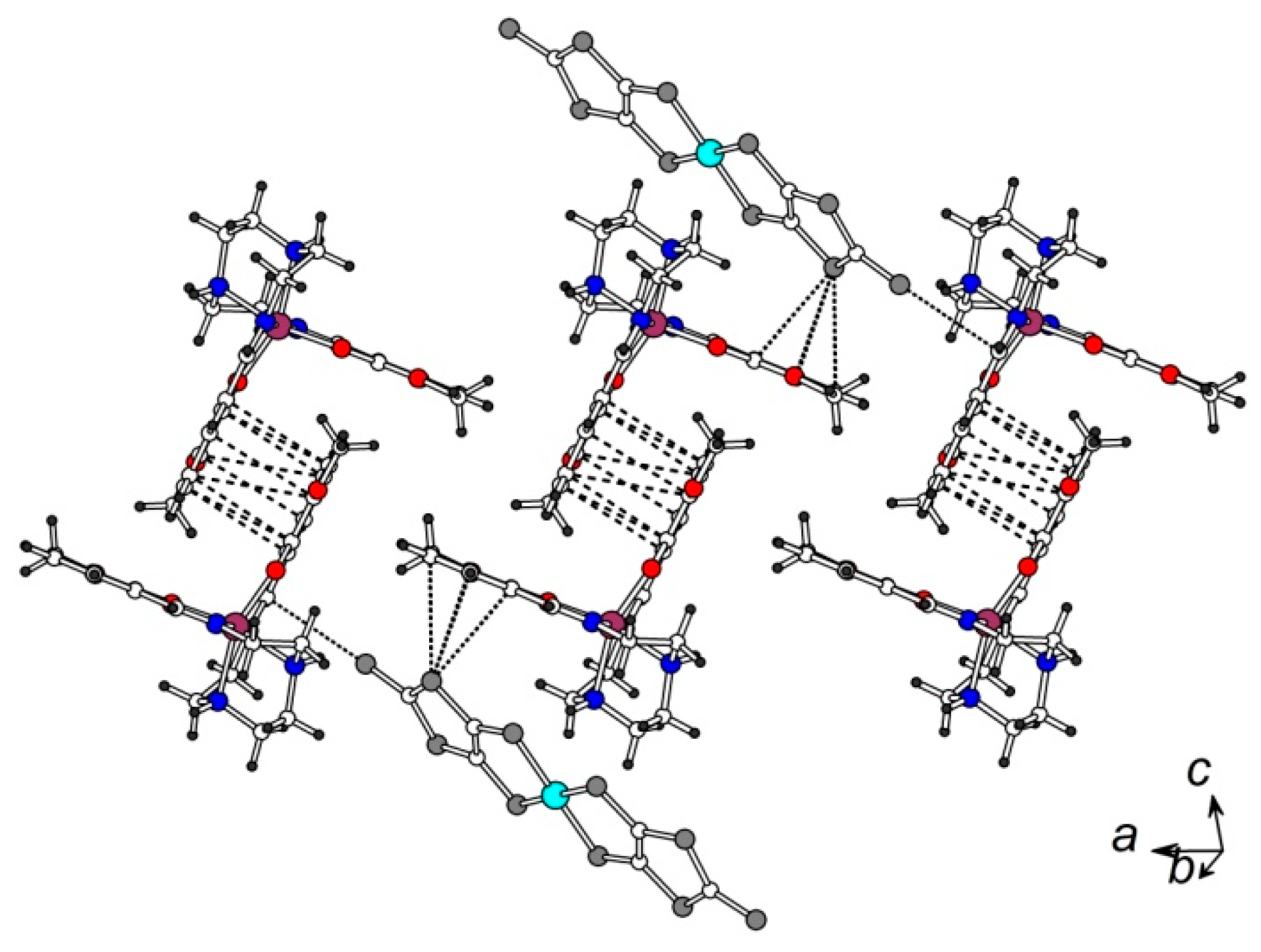

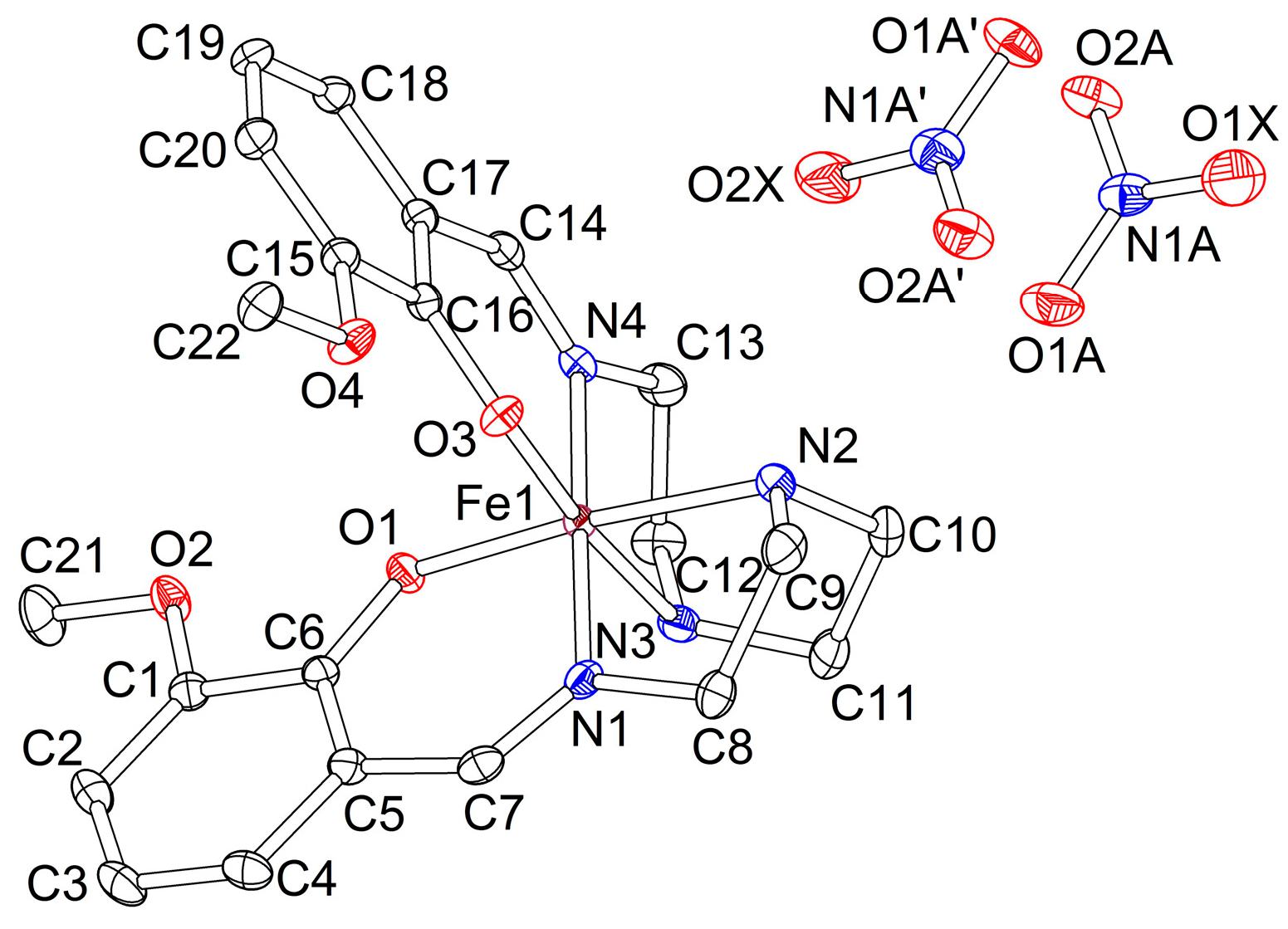


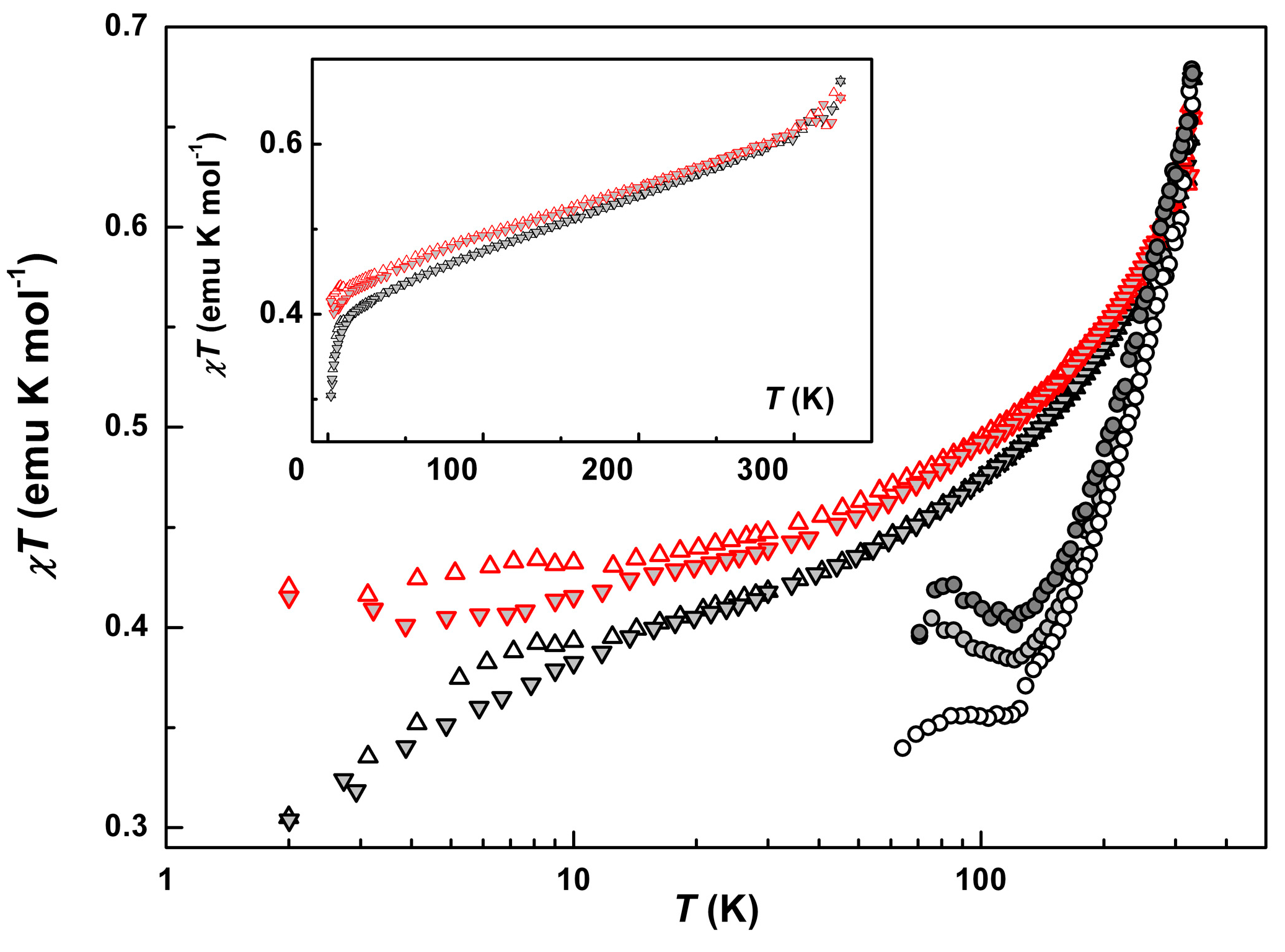
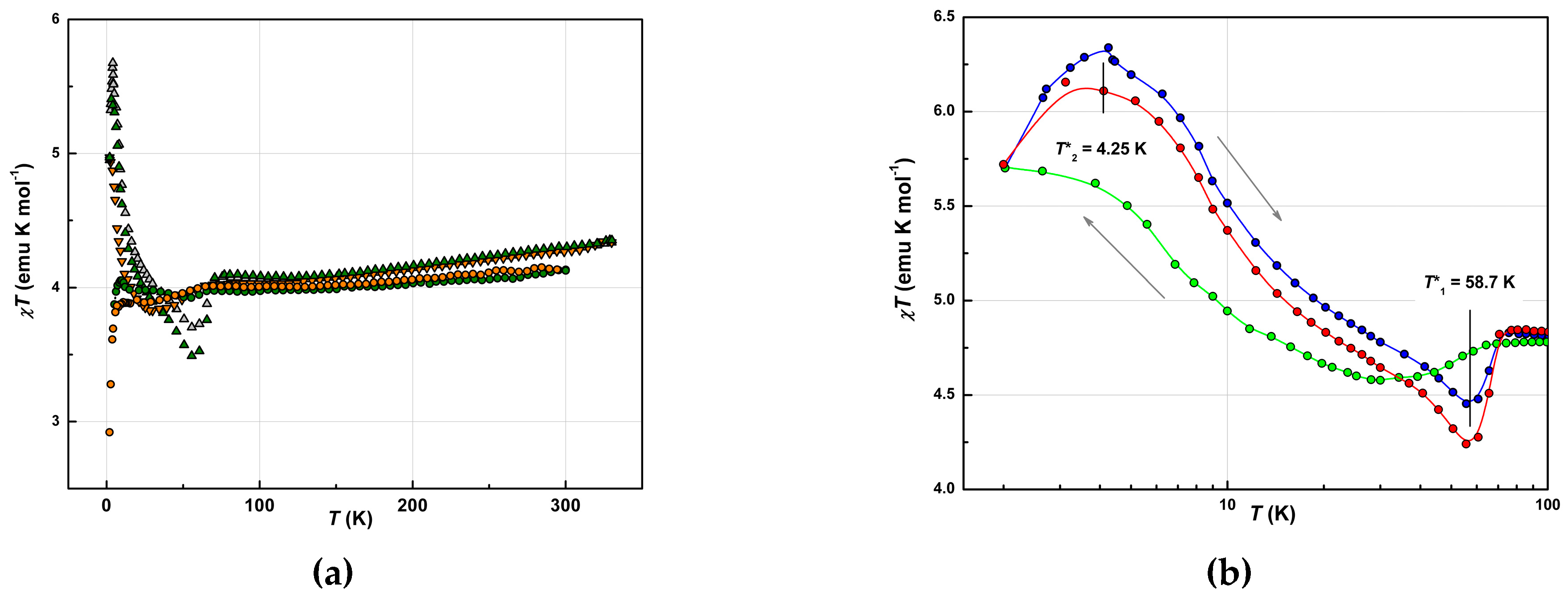

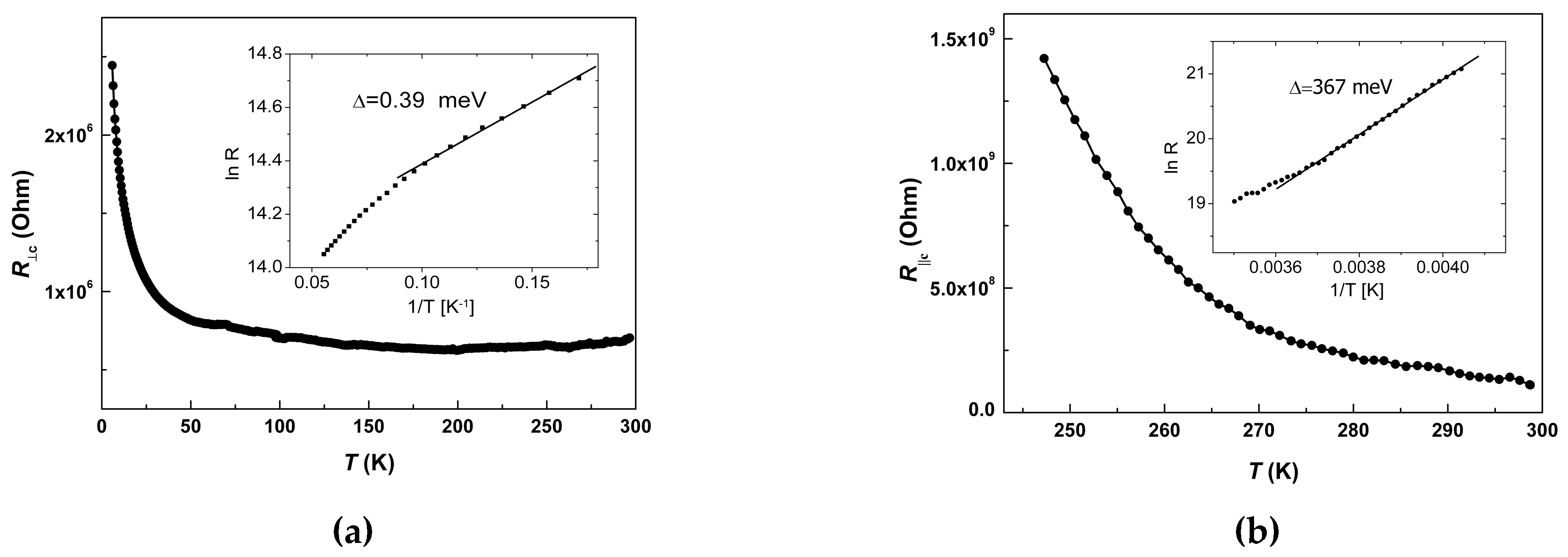
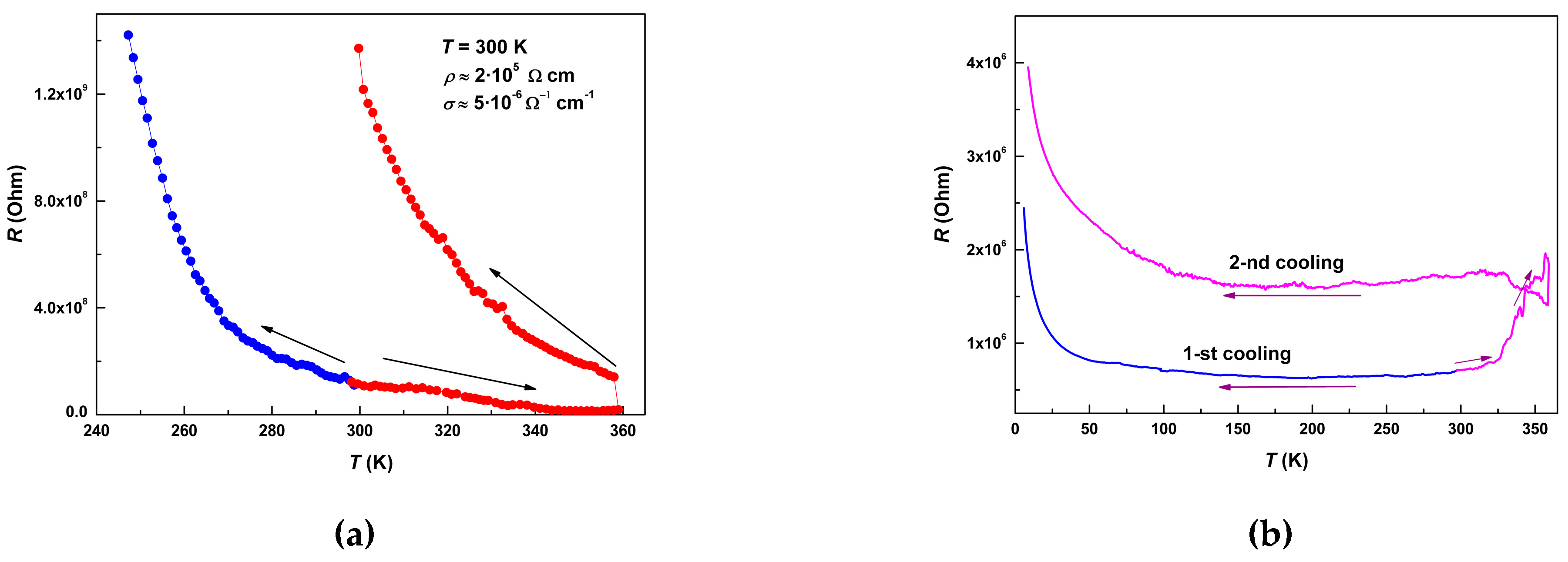
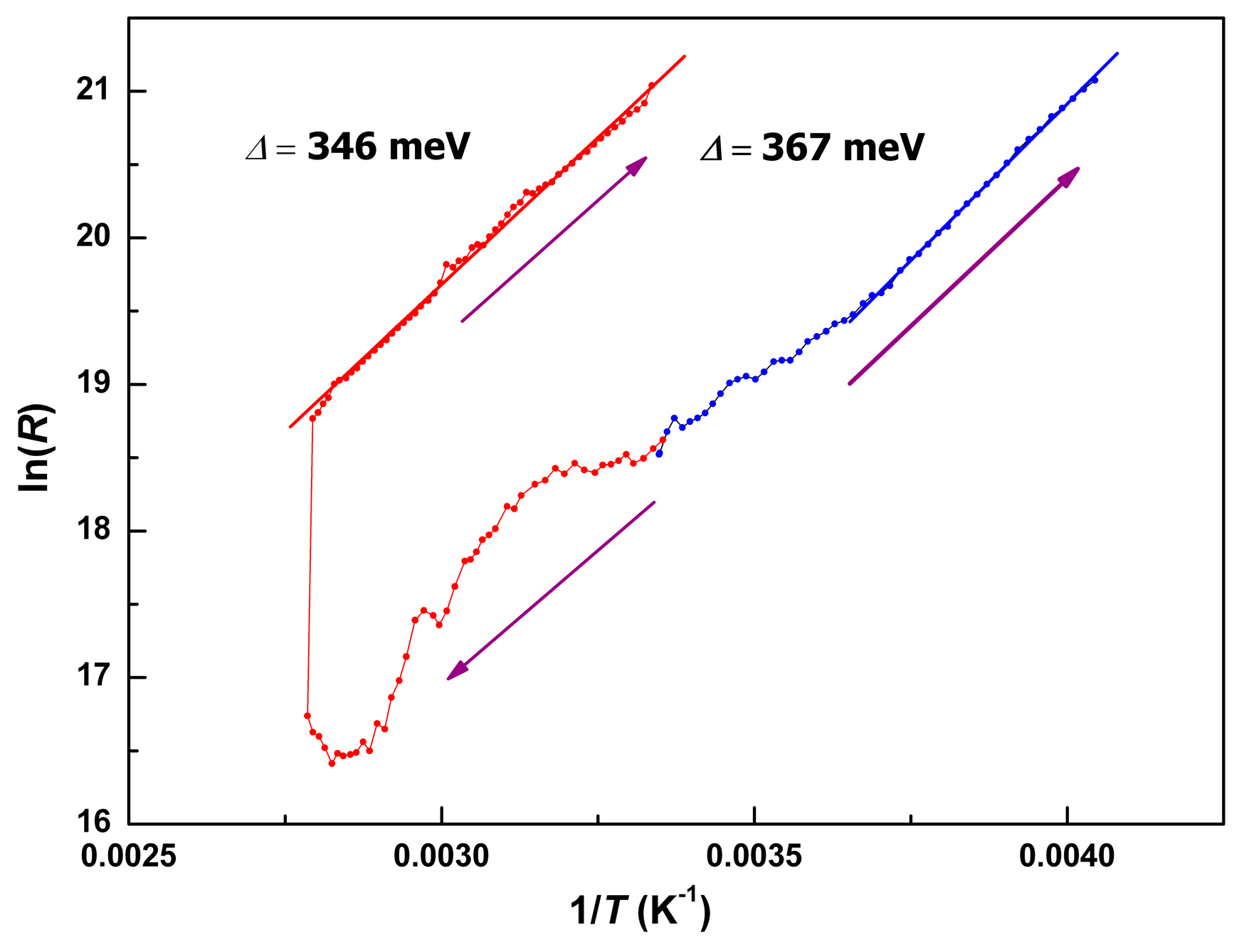

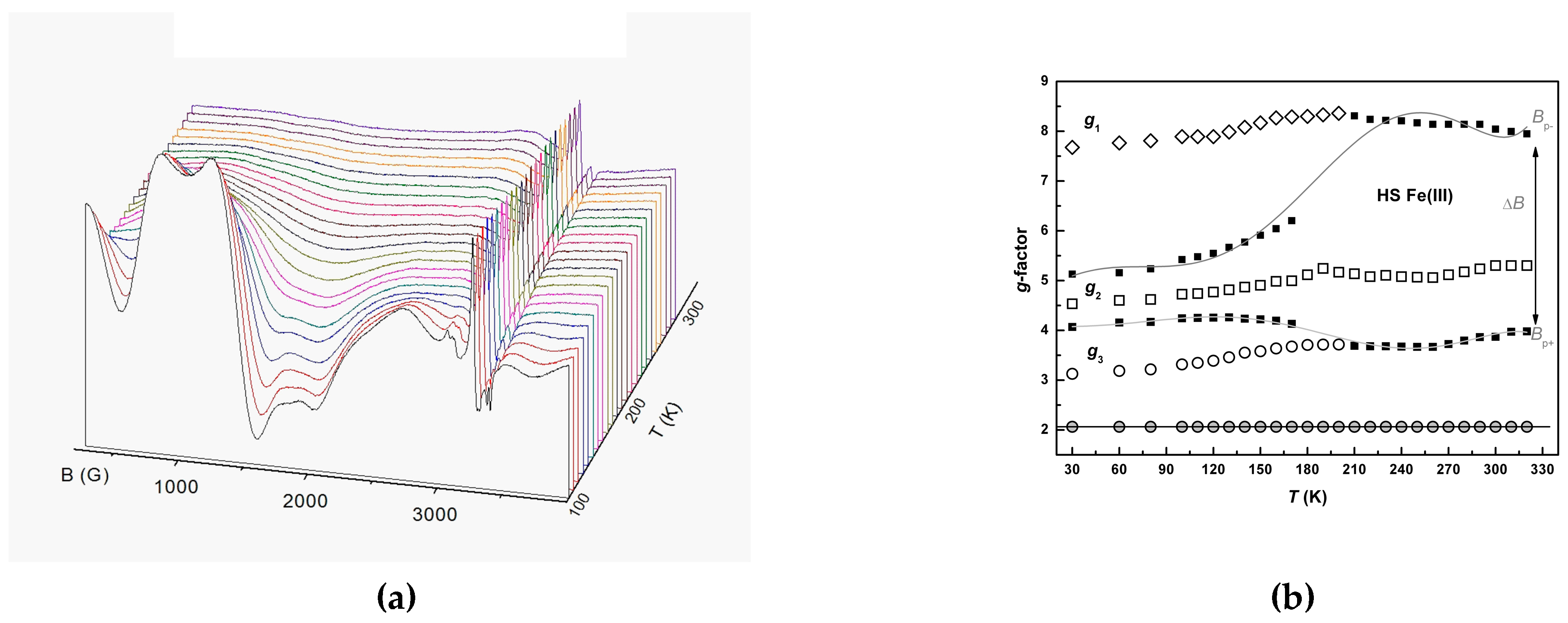
| 1, 120 K | 2, 120 K | 2, 293 K | 3, 100 K | 3, 293 K | |
|---|---|---|---|---|---|
| Fe1 O1 | 1.909(2) | 1.873(1) | 1.874(1) | 1.917(1) | 1.915(2) |
| Fe1 O3 | 1.913(2) | 1.873(1) | 1.873(1) | 1.915(1) | 1.905(2) |
| Fe1 N1 | 2.120(2) | 1.926(1) | 1.927(1) | 2.119(2) | 2.111(3) |
| Fe1 N2 | 2.173(2) | 2.005(2) | 2.006(1) | 2.167(2) | 2.184(3) |
| Fe1 N3 | 2.171(2) | 1.996(1) | 2.001(1) | 2.175(2) | 2.171(3) |
| Fe1 N4 | 2.103(2) | 1.924(1) | 1.927(1) | 2.117(2) | 2.109(3) |
| O1 Fe1 O3 | 105.41(8) | 95.61(6) | 95.48(4) | 106.21(6) | 105.4(1) |
| O1 Fe1 N1 | 86.45(8) | 94.30(6) | 94.08(4) | 84.93(7) | 85.0(1) |
| O1 Fe1 N2 | 160.47(8) | 174.02(6) | 173.90(5) | 160.73(7) | 160.8(1) |
| O1 Fe1 N3 | 93.70(8) | 89.23(6) | 89.34(5) | 94.74(7) | 95.0(1) |
| O1 Fe1 N4 | 88.92(8) | 86.32(6) | 86.63(4) | 86.37(7) | 86.7(1) |
| O3 Fe1 N1 | 96.43(7) | 87.02(6) | 87.23(4) | 100.56(6) | 100.1(1) |
| O3 Fe1 N2 | 87.96(8) | 90.07(6) | 90.23(5) | 86.53(7) | 86.9(1) |
| O3 Fe1 N3 | 155.23(8) | 174.72(6) | 174.62(5) | 152.92(7) | 153.6(1) |
| O3 Fe1 N4 | 87.34(8) | 93.24(6) | 93.16(4) | 87.41(7) | 87.6(1) |
| N1 Fe1 N2 | 77.81(8) | 84.12(7) | 84.04(5) | 78.43(7) | 78.3(1) |
| N1 Fe1 N3 | 100.42(8) | 94.74(6) | 94.85(5) | 98.16(7) | 98.2(1) |
| N1 Fe1 N4 | 174.67(8) | 179.31(6) | 179.16(5) | 169.56(7) | 169.9(1) |
| N2 Fe1 N3 | 78.07(8) | 85.16(7) | 85.06(5) | 78.24(7) | 78.3(1) |
| N2 Fe1 N4 | 106.17(8) | 95.24(6) | 95.22(5) | 109.02(7) | 108.8(1) |
| N3 Fe1 N4 | 77.24(8) | 84.95(6) | 84.70(5) | 76.80(7) | 76.8(1) |
| α | 94.39(6) | 75.84(4) | 75.24(3) | 106.12(5) | 103.6(1) |
| angle (i-ii) | 88.1(1) | 31.2(1) | 31.7(1) | 85.7(1) | 86.0(3) |
| angle (ii-iii) | 84.3(1) | 30.5(1) | 31.0(1) | 80.4(1) | 81.2(2) |
| angle (i-iii) | 35.4(1) | 25.5(1) | 25.1(1) | 38.3(1) | 38.0(3) |
| 1 | 2 | 2 | 3 | 3 | |
|---|---|---|---|---|---|
| Chemical formula | C28H28FeN4NiO4S10 | C22H30FeN5O8 | C22H30FeN5O8 | C22H28FeIN4O4 | C22H28FeIN4O4 |
| Formula weight | 919.70 | 548.36 | 548.36 | 595.23 | 595.23 |
| Temperature (K) | 120 | 120 | 293 | 100 | 293 |
| Cell setting | triclinic | monoclinic | monoclinic | monoclinic | monoclinic |
| Space group, Z | P-1, 2 | P21/c, 4 | P21/c, 4 | P21/n, 4 | P21/n, 4 |
| a (Å) | 10.4149(8) | 17.7659(8) | 17.9547(3) | 10.9107(1) | 10.6616(3) |
| b (Å) | 10.8546(9) | 9.5962(4) | 9. 6817(1) | 17.223(1) | 17.6910(3) |
| c (Å) | 17.662(1) | 14.4516(7) | 14.4568(2) | 13.7678(9) | 13.4855(2) |
| α (o) | 74.178(2) | 90 | 90 | 90 | 90 |
| β (o) | 80.256(2) | 110.495(1) | 110.178(2) | 106.136(1) | 104.866(2) |
| γ (o) | 68.484(1) | 90 | 90 | 90 | 90 |
| Cell volume (Å3) | 1781.8(2) | 2307.8(2) | 2358.82(6) | 2403.0(3) | 2458.42(9) |
| Crystal size (mm) | 0.22 × 0.15 × 0.14 | 0.29 × 0.26 × 0.13 | 0.60 × 0.19 × 0.05 | 0.45 × 0.43 × 0.35 | 0.57 × 0.36 × 0.15 |
| ρ (Mg/m3) | 1.714 | 1.578 | 1.544 | 1.645 | 1.608 |
| μ (cm−1) | 15.63 | 7.14 | 6.99 | 19.47 | 19.03 |
| Refls collected/unique/observed with I > 2σ(I) | 21631/9461/6661 | 27190/6138/5239 | 23118/6700/5748 | 18375/6360/5558 | 36353/8470/5887 |
| Rint | 0.0399 | 0.0396 | 0.0242 | 0.0236 | 0.0260 |
| θmax (o) | 29.00 | 29.00 | 31.01 | 29.00 | 32.71 |
| Parameters refined | 439 | 364 | 385 | 297 | 291 |
| Final R1(obs), wR2 (all) | 0.0365, 0.0732 | 0.0390, 0.0930 | 0.0310, 0.0870 | 0.0270, 0.0856 | 0.0568, 0.1758 |
| Goodness-of-fit | 0.999 | 1.058 | 1.055 | 1.014 | 1.078 |
| Residual electron density (e Å−3) | 0.461/−0.394 | 0.413/−0.549 | 0.372/−0.319 | 0.849/−0.829 | 2.364/−1.762 |
| CCDC reference | 2031156 | 2031157 | 2031158 | 2031159 | 2031160 |
Sample Availability: Samples of the compounds 1, 2, 3 are available from the authors. |
Publisher’s Note: MDPI stays neutral with regard to jurisdictional claims in published maps and institutional affiliations. |
© 2020 by the authors. Licensee MDPI, Basel, Switzerland. This article is an open access article distributed under the terms and conditions of the Creative Commons Attribution (CC BY) license (http://creativecommons.org/licenses/by/4.0/).
Share and Cite
Shvachko, Y.N.; Spitsyna, N.G.; Starichenko, D.V.; Zverev, V.N.; Zorina, L.V.; Simonov, S.V.; Blagov, M.A.; Yagubskii, E.B. Magnetism, Conductivity and Spin-Spin Interactions in Layered Hybrid Structure of Anionic Radicals [Ni(dmit)2] Alternated by Iron(III) Spin-Crossover Complex [Fe(III)(3-OMe-Sal2trien)] and Ferric Moiety Precursors. Molecules 2020, 25, 4922. https://doi.org/10.3390/molecules25214922
Shvachko YN, Spitsyna NG, Starichenko DV, Zverev VN, Zorina LV, Simonov SV, Blagov MA, Yagubskii EB. Magnetism, Conductivity and Spin-Spin Interactions in Layered Hybrid Structure of Anionic Radicals [Ni(dmit)2] Alternated by Iron(III) Spin-Crossover Complex [Fe(III)(3-OMe-Sal2trien)] and Ferric Moiety Precursors. Molecules. 2020; 25(21):4922. https://doi.org/10.3390/molecules25214922
Chicago/Turabian StyleShvachko, Yuri N., Nataliya G. Spitsyna, Denis V. Starichenko, Vladimir N. Zverev, Leokadiya V. Zorina, Sergey V. Simonov, Maksim A. Blagov, and Eduard B. Yagubskii. 2020. "Magnetism, Conductivity and Spin-Spin Interactions in Layered Hybrid Structure of Anionic Radicals [Ni(dmit)2] Alternated by Iron(III) Spin-Crossover Complex [Fe(III)(3-OMe-Sal2trien)] and Ferric Moiety Precursors" Molecules 25, no. 21: 4922. https://doi.org/10.3390/molecules25214922





